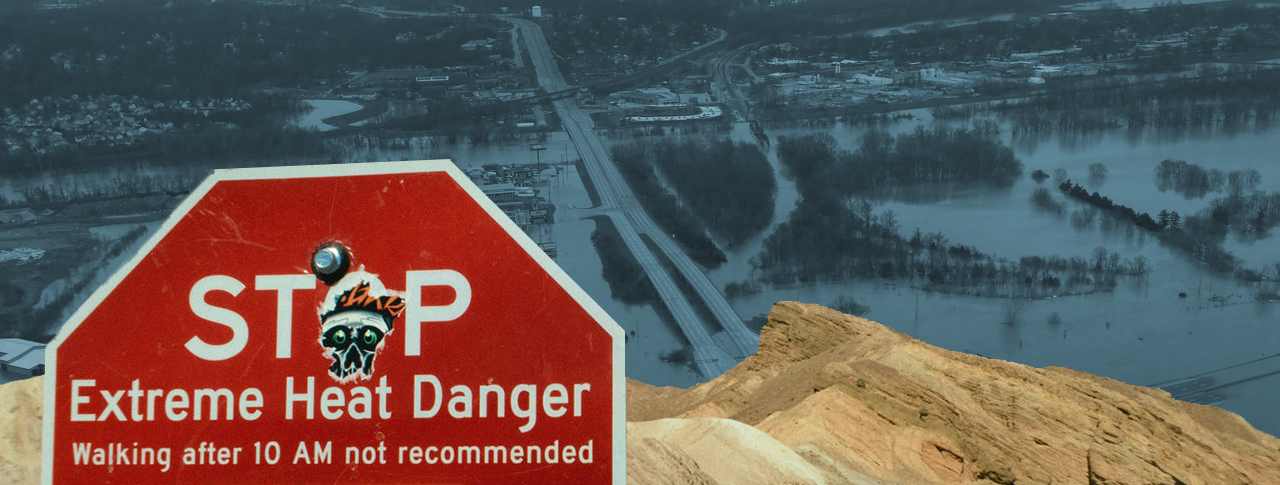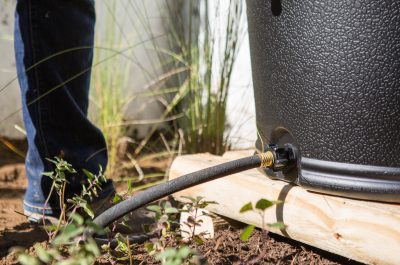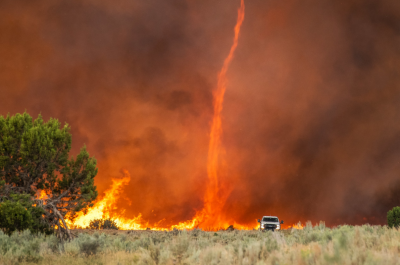Last year was the second-hottest year on record globally and ISeeChangers noticed: They documented how extreme heat, unusual precipitation and natural disasters affected their health, communities and daily life. From Boston to France to Nigeria, community members proved again and again that climate change is not a future problem, but a current reality.
Across the U.S., weather disasters in 2019 were expensive and totaled $45 billion in costs.
American disaster costs were particularly high thanks to another record: 2019 was the second-wettest year on record in the Lower 48, only missing the wettest year by 0.18 of an inch.
Why what you see matters
In a study just published in January, scientists from the Institute for Atmospheric and Climate Science in Switzerland found that, “The fingerprint of climate change is detected from any single day in the observed global record since early 2012.” That was the same year that ISeeChange first began reporting on citizen-sourced climate impacts. At the time, climate scientists were hesitant to connect individual weather events to climate trends. Yet time and time again, we’ve seen every day people on ISeeChange detecting unusual changes in their communities before scientific analysis or modeling can catch up. That’s why our team is listening so closely and creating new features for every global citizen to contribute new knowledge to their community.
As you read through the posts from last year, reflect with us: How does today compare to last year? Have you been reporting the same phenomena and seeing patterns? Did we miss anything? You can post anything on ISeeChange.org from anytime, just change the date if you need to. Every post counts to tell the bigger picture stories from your back yard- season to season, year to year.
What we saw through your eyes in 2019
A wet winter in the West soaked drought-stressed land
The winter and spring of 2019 brought relief to the drought-stricken western U.S. According to the United States Drought Monitor, at the end of September 2018, 86 percent of the West was experiencing some level of drought.
But by June 2019, that percentage flipped around with only about 13 percent of the West still experiencing a mild level drought.
Unusual levels of accumulated snow led to school cancellations, road closures and more.
In some cases, snow accumulations proved unstable and the state experienced a record breaking avalanche season which caused eight fatalities in Colorado.
Nonetheless, ISeeChangers celebrated the snow, hoping that it would stave off another devastating drought and wildfire season. Precipitation continued throughout the spring, and so did cool temperatures which allowed for snow to stick around on the mountains longer than in past years. In mid-July an ISeeChanger in Erie, Colorado reported that he was still able to see snow on the mountains around him.
— Jim Dyer
In other places, warm temperatures caused what community members expected to fall as snow to be rain instead.
As rivers swelled, one long-time ISeeChanger worried about flood risk, a distinct change from the previous year when she’d worried about drought.
For the most part, drought relief did result in a less severe fire season. Across the U.S., the year had the second-fewest fires and the sixth lowest amount of land consumed by fires in the last 20 years. That being said, ISeeChangers in Northern California were impacted by smoke and power outages associated with fires in their area.
In Southern California, fires were fanned by unusually strong Santa Ana winds which can quickly dry out land.
Cold and a snowy late-winter led to a floody spring in the Midwest
The West wasn’t the only part of the U.S. that experienced a wet winter, the Midwest did as well.
The upper Midwest went into 2019 already oversaturated after a very wet fall 2018. In January, a polar vortex brought record-breaking cold to parts of the Midwest as well as the Northeast freezing the wet ground solid.
Though the winter started off lacking snow, that changed quickly in February when ice and snow piled on top of frozen ground and waterways.
When temperatures suddenly warmed, that same snow melted rapidly on-top of that same oversaturated and frozen ground. The resulting runoff led to flooding across the region which lasted for several months. At ISeeChange, we wrote a deep dive story about how climate change made that flooding worse.
The Mississippi and Illinois rivers flooding at Grafton, Illinois.
River levels stayed high throughout the year, especially along the Mississippi. Flooding along the Mississippi, Arkansas and Missouri rivers accounted for $20 billion in costs — nearly half the total sum from natural disasters in 2019. High Mississippi River levels also caused problems downstream. In addition to fears of breached levees in flood prone southern communities, like New Orleans.
The nutrient saturated waters polluted the Gulf Coast, causing marine ecosystem die-offs, beach closures, and fisheries to suffer. These impacts underscore the interconnections of our nation’s ecosystems.
A severe allergy season in the East
From New Orleans to North Carolina, the spring of 2019 kicked off with pollen filled air in the southeastern U.S. that caused health concerns for some ISeeChangers. We did a deep dive story about the impacts of climate change on allergies and children’s health.
In the Midwest and northeast, a cool spring and early summer staved off severe allergy symptoms for longer than usual, but when allergies hit, they hit hard.
I think I’m usually well into a regiment of OTC allergy treatments by Memorial Day Weekend though! Interested that I made it this far into May
One ISeeChangers reported that he and his wife were suffering from allergies for the first time ever.
In recent decades the rate of deaths from respiratory illnesses has increased, a condition that ISeeChange continues to monitor – be sure to let us know if you’re experiencing related changes.
ISeeChangers across the globe experienced extreme heat.
As spring transitioned into summer, ISeeChanger’s health concerns moved from allergies to heat. In fact, extreme heat was the most common trend observed by ISeeChangers across the globe. In the southern hemisphere, the summer of 2019 brought heat so extreme that it burned fruit crops in Australia.
Oranges are burned. Several prolonged heatwaves during Southern Hemisphere summer.
Further north, an ISeeChanger in Abuja, Nigeria dealt with high temperatures in May that not even watermelon could quench. “The temperature of the fruit was equivalent to that of a hot tea,” she wrote.
In India, one ISeeChanger described the air as feeling like fire. “We cannot go out of our house in the day time,” he wrote. “To reduce the heat we sprinkle water on the ground and on the roads in front of our house we are trying to plant more and more plants near our house.”
No clouds and scorching heat making unable to bear. Day by day heat is increasing.
May also brought heatwaves to the southeastern U.S. with temperatures climbing near 100°F in North Carolina.
High temperatures caused health concerns for vulnerable people like outdoor workers, older adults, kids and people with disabilities. We wrote a deep dive story about a Wisconsin woman dealing with heat, poverty and disability.
My apartment has a single small AC wall unit in the living room. Running this unit is the #1 expense for utilities all year long. Box-fans on the floor blow toward our bedrooms, and I mounted window-fans at the top of doorways to help push hot air back toward the AC unit. This usually circulates enough cool air back to my bedroom to keep it below 80 degrees.
I use night-time cooling religiously; the instant it’s cooler outside than inside, open up the windows and doors, run fans to draw in cold and blow out heat. Then close things up the instant it’s warmer outside than in. But nights have been too hot for this to work like it usually does–heat’s building up in the apartment and the attic above.
Last night, it never got cool enough to open the doors and windows. With the heat slowly creeping down from the attic, it rose to 85 degrees in my bedroom by 2 a.m., and it was still 88F outside. I finally grabbed a large ice-pack from the freezer, put it under my chest, and cooled down enough to sleep.
It’s depressing to think that this will be our future. I have a disability, and I’m really hurting today because I couldn’t sleep last night. How can I possibly stand it if there are long weeks of this every year in coming years? For someone who’s disabled, poverty doesn’t tend to get better–it gets worse, and my housing situation could get worse, my access to AC will end, and I’m not going to live through that.
Also, here is a picture of the frogs my daughter rescued from the window-wells of our building (they get stuck there and die), just before she took them over to the creek and set them free. Heat is depressing; a daughter carrying five frogs in her shirt, that makes me happy!
Heat also caused irritation and a lack of focus for ISeeChangers, and transportation from biking to subways was uncomfortably hot. To cope, many people set up fans and stayed inside. One ISeeChanger visiting France during a summer heatwave sought out historic buildings to stay cool.
Helped also to be travelling on a bus with A/C.
Arriving in Caen, where it is a balmy 33 degrees and the cooling rain will come this evening.
Meanwhile, Paris hit the projected 42 degrees, destroying the old record.
In Boston, ISeeChange partnered with the Museum of Science to map heat across the city. Check out our community investigation write-up about what we learned.
New Orleans flooded, again and again.
In addition to heat, many ISeeChangers dealt with flooding over the warm months as well. ISeeChangers in New Orleans documented four major floods in 2019 alongside neighborhood specific flooding all year. Rain gauge hosts demonstrated how localized heavy rain can be while photos showed how high flood waters reach after different rain amounts.
On April 4, 2019, flooding was caused in the Gentilly neighborhood when over three inches of rain fell in a period of seven hours.
Out street is flooded. It was about half an inch from being in the car. .74 in 20 minutes
On May 12, 2019, rain gauge hosts reported nearly seven inches of rain in the Treme area, while not-far away, hosts in the Gentilly area received 4.5 inches. The high rate of rain caused significant flooding.
July 10, 2019 saw the biggest flood of the year in New Orleans. A rain gauge host in the Mid-City area collected 8.6 inches of rain in just three hours. “I’ve only seen it flood like this twice in the 10 years we’ve had this house,” one ISeeChanger wrote.
The final major flood of the year occured on August 26, 2019. During this storm, rain totals across the city were extremely varied with heavy rain and flooding very localized. In the Broadmoor neighborhood, a rain gauge host in the south collected 6.6 inches of rain while a host in the western part of the neighborhood collected 3.79 inches. Meanwhile in Gentilly, a gauge host recorded only 1.05 inches of rain in the same time period.
Check out our New Orleans community investigation write-up to read more about what we learned and how the data we’ve collected is being used to inform adaptation efforts.
Coastal communities faced flooding.
Beyond New Orleans, ISeeChangers in coastal communities experienced severe summer flooding in 2019 too and not just from rain. High tides, rain storms, tropical storms and nor’easters all caused flooding to coastal communities in the Eastern U.S. this last year. ISeeChangers on the coast documented beach erosion, street flooding and damage left after floods.
11′ 8″ high tide with storm surge. Flooding at least 50 yards up the street from the salt marsh.
ISeeChangers in Ocean City, New Jersey worked together to document the flood events that they experienced in the hopes of influencing their city officials to implement more solutions. You can learn more by reading our community investigation write-up .
With the Coastal Review Online, ISeeChange is working to track coastal flooding in North Carolina as well. ISeeChangers in North Carolina documented how high tides during a nor’easter caused flooding.
High tide in ICWW SATURDAY, Nov. 16th as nor’easter was strengthening offshore.
In 2020, ISeeChange will be working with the City of Miami to map how flooding impacts the community there.
The intersection of NE 25th Street and NE 2nd Avenue floods in pretty much every single storm, so the flooding there wasn’t a surprise. But for the first time that I’ve seen, water was lapping at the doors of a few storefronts along NE 2nd Avenue. And even parts of Biscayne Boulevard, the major artery north of downtown, had an inch or two or standing water in the gutters.
Wild temperature swings in fall and spring.
In addition to flooding, ISeeChangers observed rapid temperature changes, particularly in the fall and spring. In late May, ISeeChangers in New England reported the weather quickly switching from cold and rainy to nearly 90°F degrees in a two day span.
This is a change. We just went through a Nor’easter and now it is 90 degrees outside.
And in the fall, ISeeChangers from Colorado to Texas to Washington D.C. reported temperatures dropping over 30°F in one day.
Yesterday 10/9/19 it was 80° outside and sunny. Today it is snowing and 21° outside.
This trend wasn’t just confined to the U.S. An ISeeChanger in Moscow, Russia reported a rapid decline in temperatures that people were unprepared for. “I don’t remember that such a sudden drop ever happened, at least not so early. public utilities were not ready for this and some flats are still not heated (my flat is not, for example),” she wrote.
ISeeChange continues to investigate the impacts and science behind “Weather Whiplash” – stay tuned and keep telling us about what you’re seeing.
International precipitation trends
From flooding in China to drought-stressed blueberries in Mexico, ISeeChangers from outside the U.S. documented heavy rain, drought and other strange precipitation trends in their own backyards.
Kenya precipitation weirdness
Kamweti Mutu has been documenting precipitation in Nairobi, Kenya since 2017. In 2019, after a relatively normal January through March, Mutu observed very dry conditions in early April when spring rains didn’t arrive on time.
The rains did eventually arrive, and Mutu wondered if cyclones early in the year might have affected precipitation patterns. Cyclone Idai, which made landfall in central Mozambique on March 15 and affected over three million people, was one of the strongest known cyclones to make landfall in East Africa. Cyclone Kenneth followed in April, and marked the first time in history that a tropical cyclone impacted northern Mozambique. This was the first season on record with two major cyclones hitting Mozambique.
Mutu reported that the summer months were relatively normal, albeit warm, but the “short rains” season of October – December came through even stronger than usual.
Wet spring, dry summer in Europe
In some parts of Europe, spring 2019 was rainier than usual. Spain had its wettest April since 2008 and the fourth wettest since national records began in 1965.
But summer heat and lack of rainfall, caused much of central and western Europe to fall into drought conditions in later months. Paris, France had a total of 34 consecutive days without rain which tied its second-longest dry spell on record.
Drought, heat and fire in Australia
The heat trends seen early in 2019 continued into summer in the southern hemisphere. It brought, and continues to bring, dangerous heat, drought and wildfires to Australia. An Australian ISeeChanger reported warning signs in the spring when conditions were warm and windy.
For an ISeeChanger living in rural New South Wales the drought has hit way too close to home. “One year of drought is devastating. Two years is worse. Three years is unrelenting hardship,” She wrote. “The type of disaster that makes you cry when you see rain clouds drift over or around your farm. Or watching a couple of cattle that are so malnourished by missing out on what is hand fed to them, they can’t navigate through a gate that’s been opened for 3 months to get to the hay. To see them headbutting the fence, to see their ribs stick out, makes me sad. This is the fourth summer in a row in rural NSW we have been in drought. That’s forty consecutive months with much lower than average rainfall if any. It is soul destroying.”
Talking about climate action and climate grief
In 2019 ISeeChangers also posted stories of how they were taking action or searching for solutions for climate challenges. ISeeChangers in Berlin, Boston and New Orleans shared photos from youth-led climate action marches.
And other ISeeChangers posted stories mourning changes to their favorite places.
The ISeeChange team is listening to concerns from our community. In 2020, we aim to understand how our community climate network can help steward both climate trauma and climate solutions. Please let us know in your posts what solutions and healing you see possible.
Tracking 2020
2019 was a year of change for all of us, and just because the calendar says it’s a new year doesn’t mean everything resets. Many weird weather trends you began to notice last year may be relevant in 2020 as well. We’re already seeing signs of winter weirdness and a never ending growing season in the U.S. with warm weather leading to a very early spring in the Southeast, and winter warm-ups leading to highs in the 70s in the Northeast.
Tell us what you’re seeing, every sighting and every story counts.
Cover photo a composite of a flooding photo by the Department of Defense and an extreme heat sign photo by Pedro Sandrini.




